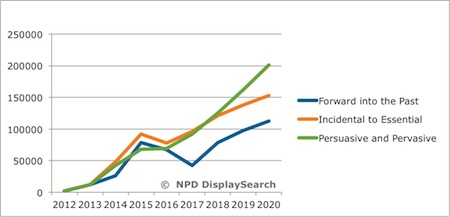 The wearables market, including activity trackers, smart watches, and head-worn displays, is expected to ship 48 million units in 2014 and 91 million in 2015, but after that, the market is expected to slow down for one or two years "as consumers rebound from the initial hype", according to a report from the NPD Group.
The wearables market, including activity trackers, smart watches, and head-worn displays, is expected to ship 48 million units in 2014 and 91 million in 2015, but after that, the market is expected to slow down for one or two years "as consumers rebound from the initial hype", according to a report from the NPD Group.
“We expect that the dynamics of the wearables market will be similar to DVD, LCD TV, smartphones, and other digital consumer markets with commoditized hardware,” Paul Gray, director of European TV research for NPD DisplaySearch said in a statement. “The arrival of Samsung, LGE, and other large, cost-efficient manufacturers to the wearables market would bring prices and margins down.”
The research company also developed three different scenarios for the wearable device market given their uncertainty of how consumers will adopt this technology.
In the first scenario, labeled “Forward into the Past”, wealthy consumers are the first to adopt the technology, which makes the wearables desirable to other consumers. Soon, these devices get cheaper and then the market eventually expands. NPD adds that in this scenario, China will dominate the market, but when consumers start wanting the devices to be fashionable, China will face a backlash in 2017. The market for wearables in North America and Europe will decline at a slower pace than the one in China.
The second scenario, called “Incidental to Essential”, explains that consumers will start purchasing these devices casually, but wearables eventually become essential to their lives. At that point, consumers will be loyal to various devices and services, like some are to Apple's iTunes. China also dominates the market in this scenario.
The third scenario, called “Persuasive and Pervasive”, is more optimistic about the fate of wearables. In this situation, not only will wearables become essential, they will provide health benefits, inspire medical interventions, and healthcare providers will begin recommending the devices more often. Although China does end up dominating in this market, the growth would be slower.
“Increased concern about healthy living in China, and similar concerns in Europe, could lead healthcare providers to recommend activity-tracker devices to their patients,” Gray said.














